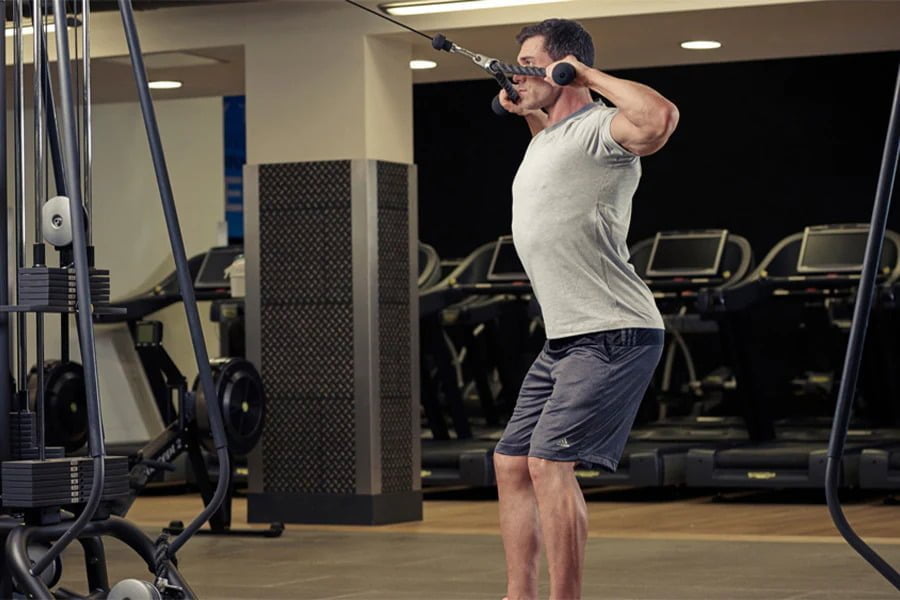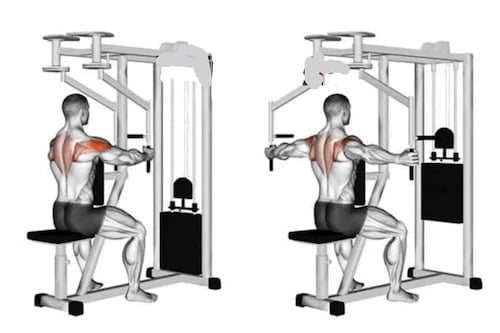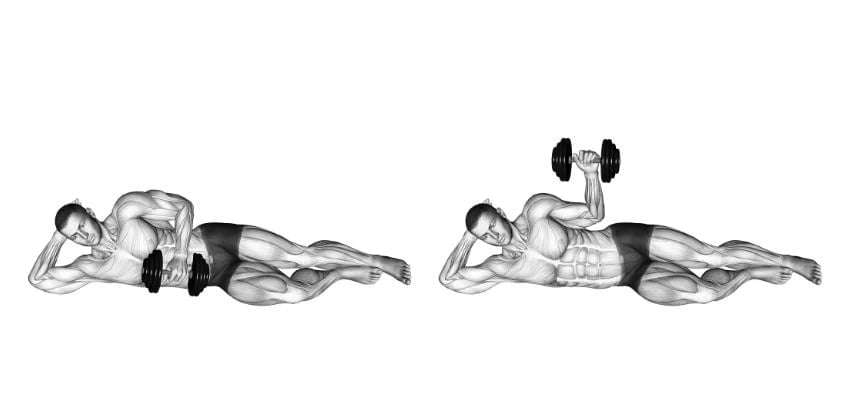It is important to include a posterior deltoid workout routine in your shoulder training program to fully target and strengthen all muscle groups in the shoulder. The rear delt, also known as the posterior deltoid, is often overlooked in traditional shoulder workouts but is crucial for maintaining proper muscle balance and preventing injury. Don’t neglect your rear delts, make sure to include a dedicated posterior deltoid workout routine in your training program.
The posterior deltoid is responsible for a number of important functions, including shoulder extension, horizontal abduction, and transverse extension. It also plays an important role in maintaining good posture and preventing injuries.
A well-rounded shoulder workout should include exercises specifically targeting the posterior deltoid in order to achieve balance and prevent injury. In this article, we will discuss the importance of posterior deltoid training, the functions of this muscle group, and the common mistakes people make when training it.
We will also provide a comprehensive workout routine for building and sculpting this often-neglected muscle group. Whether a beginner or an experienced fitness enthusiast, this routine is designed to help you achieve a well-rounded shoulder and improve your overall fitness level.
Whether you’re looking to improve posture and athletic performance, or just want to have a well-rounded shoulder, this routine is for you. This workout routine is designed to be easy to follow and can be done at home or at the gym.
SHOP FOR ADJUSTABLE DUMBBELLS SET ON AMAZON
It includes a variety of exercises that target the posterior deltoid, and it also includes tips on how to perform the activities correctly to get the most out of your workout. So, let’s start and take the first step towards a stronger and healthier you.
Importance of Posterior Deltoid Training
Posterior deltoid training is important for several reasons.
Firstly, it helps to achieve balance in the shoulders by working the muscle group that is often overlooked in training routines. When the posterior deltoids are weak, the front and middle deltoids can become overworked, leading to imbalances and potential injuries.
Secondly, strong posterior deltoids improve posture. The posterior deltoid is responsible for maintaining the correct alignment of the shoulders and preventing them from rounding forward, which is a common postural issue.
Thirdly, it improves athletic performance by providing stability and power to the shoulder joint. The posterior deltoids are involved in many upper body exercises such as rowing and pull-ups, and having strong posterior deltoids can help improve performance in these exercises.
Lastly, it also improves overall shoulder health. Strong and well-developed posterior deltoids can help prevent common shoulder injuries such as rotator cuff tears and impingements.
In short, training the posterior deltoid is essential for overall shoulder health, improved posture, and athletic performance. By including exercises specifically targeting the posterior deltoid in your training routine, you can achieve balance, prevent injury and improve your overall fitness level.
Unlocking the Power of the Posterior Deltoid: Understanding its Functions
A posterior deltoid workout routine is essential for targeting and strengthening the muscle group located on the back of the shoulder known as the rear delt. It has several important functions in the movement of the shoulder joint:
- Shoulder Extension: The posterior deltoid is responsible for extending the arm behind the body. This motion is used in exercises such as rows and pull-ups.
- Horizontal Abduction: The posterior deltoid is responsible for moving the arm away from the body in a horizontal plane. This motion is used in exercises such as lateral raises and face pulls.
- Transverse Extension: The posterior deltoid is responsible for rotating the arm outward, away from the body. This motion is used in exercises such as shoulder external rotations.
- Posture: The posterior deltoid plays an important role in maintaining the correct alignment of the shoulders and preventing them from rounding forward, which is a common postural issue.
- Stability: The posterior deltoid provides stability to the shoulder joint by helping to keep the humerus (upper arm bone) in place. This is important for preventing injuries such as rotator cuff tears and impingements.
Overall, the posterior deltoid is a crucial muscle group that plays a vital role in shoulder movement and stability. By targeting the posterior deltoid in your training, you can improve your shoulder function and overall fitness level.
Effective Posterior Deltoid Training: Overcoming Common Pitfalls
When it comes to training the posterior deltoids, it can be easy to fall into common mistakes that can hinder progress and even lead to injury. Whether you’re a beginner or an experienced athlete, it’s important to be aware of these mistakes and take steps to avoid them in order to achieve optimal results and maintain overall shoulder health. Here we are discussing some tips to avoid common mistakes during posterior deltoid training and help you achieve your fitness goals.
- Incorporating enough variety in exercises: Make sure to include a variety of exercises that target the posterior deltoids from different angles to ensure full muscle activation and avoid overuse.
- Proper form: Maintaining proper form is crucial for avoiding injury and targeting the correct muscle group. Make sure to keep your shoulders back and down while performing exercises such as reverse flys or bent-over rows.
- Using appropriate weight: Using too much weight can lead to improper form and injury. Start with a lighter weight and gradually increase as you become stronger.
- Focusing on high reps: High reps alone will not provide enough resistance to build muscle. Aim for a balance of both high and low reps to target different muscle fibers.
- Neglecting other muscle groups: The posterior deltoids work in conjunction with other muscle groups such as the upper back and rotator cuff. Make sure to incorporate exercises for these muscle groups as well to maintain balance and prevent injury.
- Avoiding stretching: Stretching is important for avoiding injury and maintaining flexibility. Make sure to include stretching exercises for the posterior deltoids in your workout routine.
- Not listening to your body: If you feel pain or discomfort while performing an exercise, it is important to stop and reassess your form. Always listen to your body and avoid pushing it too hard to avoid injury.
Exercises to Improve Posterior Deltoid Strength
The posterior deltoid, also known as the rear deltoid, is a muscle located in the back of the shoulder. It is responsible for shoulder extension and external rotation. Strong posterior deltoids are important for proper shoulder function and can help prevent injury. Here are some exercises that can be used to improve posterior deltoid strength:
1. Single-arm Bent-over Row

The Single-arm bent-over row is a great exercise for targeting the posterior deltoid as well as the upper back muscles. This exercise can be performed with a dumbbell or a resistance band.
SHOP FOR ADJUSTABLE DUMBBELLS SET ON AMAZON
Steps to follow
- Start by standing with your feet hip-width apart and a slight bend in your knees.
- Hinge forward at the hips until your upper body is almost parallel to the ground. Keep your back flat and your core engaged.
- Hold a dumbbell in one hand and let it hang at arm’s length.
- Keep your elbow close to your body, and pull the dumbbell up to the side of your ribcage.
- Pause and then slowly lower the weight back to the starting position.
- Repeat the movement for the desired number of reps and then switch sides.
Pro tip:
- Keep your trunk stable and avoid rotating it during the movement. If you can’t keep your trunk stable, either reduce the weight or stop the set and rest before starting again.
2. Standing Bent-over Lateral Raise

The standing bent-over lateral raise is an exercise that targets the posterior deltoids. It can be done using dumbbells or a resistance band.
Steps to follow
- Stand with your feet shoulder-width apart and hold a pair of dumbbells or a resistance band with your palms facing inward.
- Slightly bend your hips and keep your back straight as you bend forward.
- With a slight bend in your elbows, lift the weights or band out to the side, keeping your elbows close to your body.
- Pause for a moment and lower the weights or band back to the starting position.
- Repeat for the desired number of reps.
Pro tip:
- During the exercise, try to keep your head in line with your trunk.
3. Cable Machine High Pull With Ropes

The cable machine high pull with ropes is an exercise that targets the posterior deltoid as well as other upper body muscles such as the upper back and biceps. The exercise is done using a cable machine with a rope attachment. The ropes are grasped with both hands and pulled toward the face in an upward motion.
Steps to follow
- Stand facing the cable machine with your feet hip-width apart.
- Take hold of the rope attachment with both hands, with your arms fully extended in front of you.
- Keep your core engaged, and using your upper body, pull the ropes towards your face, drawing your elbows up and out to the sides.
- Make sure to keep your back straight and your chest up.
- Slowly release the tension in the ropes and return to the starting position.
- Repeat for the desired number of reps and sets.
Pro tips:
- Bend your elbows 45-90 degrees away from your sides when pulling the rope apart and toward your chest.
- Lower your elbows to your comfort level if you experience pain or stiffness with your elbows 90 degrees away from your sides (parallel to your shoulders).
- Keep your head up, looking straight ahead, and your torso tall so your back does not arch.
- You can also do this exercise while holding a resistance band in front of you.
4. Rear Deltoid Machine

The rear deltoid machine, also known as the reverse fly, is a strength training exercise that targets the posterior deltoids. This exercise can be done using a machine specifically designed for this exercise, or with dumbbells or resistance bands.
SHOP FOR RESISTANCE BANDS ON AMAZON
Steps to follow
- Sit facing the machine with your feet flat on the ground and your knees bent.
- Grasp the handles of the machine with your palms facing inwards.
- Keep your elbows slightly bent and pull the handles outwards and backward, squeezing your rear deltoids as you do so.
- Slowly release the handles back to the starting position.
- Repeat the exercise for the desired number of reps and sets.
Pro tip:
- Maintain a firm grip on the pad and avoid arching your back.
5. Assisted Pullup

Assisted pull-ups are a great exercise for building posterior deltoid strength. This exercise can be done using a machine or with the help of a partner. The exercise is performed by pulling yourself up towards a bar, using the muscles in your back and shoulders. The assistance can be provided by using a band or by a partner pushing down on your legs while you pull up.
Steps to follow
- Stand facing the pull-up bar and place one foot in the stirrup or loop of a resistance band.
- Grasp the pull-up bar with an overhand grip, hands slightly wider than shoulder-width apart.
- Begin the exercise by pulling your chest up towards the bar, keeping your elbows close to your body.
- Slowly lower yourself back down to the starting position.
- Repeat for the desired number of repetitions.
Pro tips:
- Begin with a weight that is light enough to make the exercise difficult but heavy enough to allow you to complete the movement successfully and with good form.
- If you can complete any number of reps without assistance (using proper form), you can begin without it and gradually transition to it when you can’t complete any more reps.
6. Side-lying External Rotation

The side-lying external rotation exercise is a great way to target the posterior deltoid. This exercise can be done with a resistance band or a lightweight.
Steps to follow
- Start by lying on your side on a flat surface with your elbow bent at a 90-degree angle and your hand holding the weight or band.
- Keep your elbow close to your side and slowly rotate your hand upward toward the ceiling.
- Pause at the top of the movement, then slowly lower your hand back down to the starting position.
- Repeat for the desired number of reps, then switch sides and repeat.
Pro tip:
- It is important to keep your elbow close to your side throughout the exercise to focus on the posterior deltoid and to use a weight that is light.
FAQs
Q. What muscles are weak in rounded shoulders?
Rounded shoulders, also known as “forward shoulders” or “hunched shoulders,” is a posture where the shoulders roll forward and the upper back is rounded. This posture can be caused by a combination of factors, including muscle imbalances and poor posture habits.
Typically, the muscles that are weak in rounded shoulders are the upper back and shoulder blade stabilizing muscles, such as the:
- Rhomboids
- Trapezius
- Serratus anterior
Additionally, the muscles that are responsible for pulling the shoulders back and down, such as the:
- Posterior deltoids
- Infraspinatus
- Teres minor
Are also often weak in people with rounded shoulders.
It is important to note that rounded shoulders can also be caused by muscle tightness in the chest and upper arm muscles, such as the Pectoralis major, Pectoralis minor, and anterior deltoid. To correct rounded shoulders, it is important to stretch these tight muscles and strengthen the weaker ones.
Q. How many days does it take to fix rounded shoulders?
Fixing rounded shoulders is a process that can take time and consistent effort, the exact duration of which can vary depending on a number of factors including the severity of the condition, the frequency and consistency of the exercises and stretches performed, and the individual’s overall health and fitness level.
It’s important to note that fixing rounded shoulders is not a quick fix, it’s a process that takes time and consistency. It may take several weeks or even several months of consistently working on strengthening the upper back and shoulder blade stabilizing muscles, stretching the tight chest and upper arm muscles, and correcting poor posture habits to see significant improvements in shoulder posture.
It is important to consult with a physical therapist or a personal trainer to evaluate your posture, identify any muscle imbalances and develop a workout routine that is tailored to your specific needs. It is also important to remember that it is not just about fixing the posture but also about maintaining it and preventing it from happening again.
Q. How can I fix my rounded shoulders fast?
It is important to note that fixing rounded shoulders is not a quick fix, it’s a process that takes time and consistency. However, there are some things you can do in order to see some improvement quickly:
- Improve your posture: Make a conscious effort to sit and stand up straight, pull your shoulders back and down, and engage your core muscles.
- Stretch your chest and shoulder muscles: Tight chest and shoulder muscles can contribute to rounded shoulders, so it is important to stretch these muscles regularly.
- Strengthen your upper back and shoulder blade stabilizing muscles: exercises such as rows, pull-ups, and face pulls can help to strengthen these muscles and improve shoulder posture.
- Incorporate rotator cuff exercises: The rotator cuff muscles are small muscles that stabilize the shoulder joint and help to pull the shoulders back and down.
- Consult with a physical therapist or personal trainer: They can evaluate your posture, identify any muscle imbalances, and develop a workout routine that is tailored to your specific needs.
It’s important to remember that fixing rounded shoulders is not just about a few days or weeks, it’s a process that takes time and consistency. It’s important to stick with your exercise routine, be patient and be consistent.
Conclusion
To summarise, targeting the posterior deltoid is an essential component of a well-rounded shoulder workout routine. Exercises like bent-over lateral raises, reverse flies, and face pulls can help to shape and strengthen the posterior deltoid muscles, resulting in a balanced and aesthetically pleasing shoulder appearance. It is critical to use proper form, begin with a lightweight, and gradually increase the weight as your strength increases. As with any exercise routine, it is critical to listen to your body and stop if you feel pain or discomfort.

Good day, and welcome to Fitthour. My name is Shubham Vijay, and I am a certified personal trainer and nutrition coach with 6 years of experience in the fitness industry. At Fitthour, we specialize in types of training, such as strength training, cardio, or HIIT, and our mission is to help clients achieve their fitness goals and improve their overall health.

